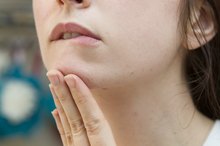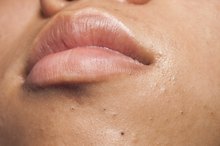Causes of Smelly Acne
When sloughed-off skin cells, excessive sebum and bacteria plug pores, acne is the result, according to the University of Maryland Medical Center 4. Whiteheads are a form of acne in which the pores are blocked by skin cells. Blackheads are plugged pores that are exposed to the air, oxidizing the surface of the plug. Pimples, pustules and cysts are plugged pores that become infected. Malodorous acne isn't a common problem, although the discharge from blocked pores may have a little odor.
Sebum Plugs
Generally, sebum moves toward the surface of the skin and acts as an emollient to preserve moisture and prevent the movement of microbes and chemicals through the skin into the body. But excessive sebum production, combined with dead skin cells, can block your pores. Occasionally it can develop the kind of odor your scalp may have.
Dead Skin Cells
Why Does Pus From Acne Have an Odor?
Learn More
As new skin cells develop in the dermis, older skin cells are pushed out. The outermost layer of skin cells, the stratum corneum, consists of about 20 layers of dead skin cells that gradually slough off. But in acne, dead skin cells can become trapped in pores, and instead of sloughing off, they form a plug with the sebum. They can begin to decay in the pores, contributing to the odor problem.
- As new skin cells develop in the dermis, older skin cells are pushed out.
- But in acne, dead skin cells can become trapped in pores, and instead of sloughing off, they form a plug with the sebum.
Bacteria
Bacteria is normally present on the skin, and some of it is beneficial. But harmful bacteria, such as Staphylococcus aureus, can also be present on the skin. Blocked pores provide a feeding ground for the bacteria and can become infected as bacteria attack the materials in the pore. The odor isn't likely to be very noticeable. If it is very noticeable, it may indicate a more serious infection, and you should see your physician, according to New York University's Langone Medical Center 4.
- Bacteria is normally present on the skin, and some of it is beneficial.
- If it is very noticeable, it may indicate a more serious infection, and you should see your physician, according to New York University's Langone Medical Center 4.
Picking and Squeezing Acne
Home Remedy for an Infected Pimple
Learn More
Picking and squeezing whiteheads, blackheads and pimples introduces dirt and more bacteria into the pores, which can worsen any odor. Bacteria can be transferred from infected pimples to blackheads or whiteheads that were not previously infected, spreading infection across the face or any other area.
Skin Care
Acne isn't caused by a lack of cleanliness. But washing your face twice a day with a gentle cleanser helps to remove bacteria and dirt. The less you touch your face, the less likely you are to introduce bacteria and dirt into your pores. Washing your hair and cleansing your face after taking off a sweaty headband or scarf helps to keep clogged pores clean. Taking a shower after taking off sweaty clothing can help prevent acne on your back, chest and shoulders. Good skin care makes it less likely that your acne will develop an odor.
- Acne isn't caused by a lack of cleanliness.
- Washing your hair and cleansing your face after taking off a sweaty headband or scarf helps to keep clogged pores clean.
Related Articles
References
- Aetna Intelihealth: Acne
- UC Davis Student Health Services: Acne
- Acne.org Message Boards: Acne Types: Body acne
- University of Maryland Medical Center: Acne
- NYU Langone Medical Center: Hidradenitis Suppurativa
- Flament F, Francois G, Qiu H, et al. Facial skin pores: a multiethnic study. Clin Cosmet Investig Dermatol. 2015;8:85–93. Published 2015 Feb 16. doi:10.2147/CCID.S74401
- Maia Campos PMBG, Melo MO and Mercurio DG (2019) Use of Advanced Imaging Techniques for the Characterization of Oily Skin. Front. Physiol. 10:254. doi: 10.3389/fphys.2019.00254
- Makrantonaki E, Ganceviciene R, Zouboulis C. An update on the role of the sebaceous gland in the pathogenesis of acne. Dermatoendocrinol. 2011;3(1):41–49. doi:10.4161/derm.3.1.13900
- Flament F, Francois G, Qiu H, et al. Facial skin pores: a multiethnic study. Clinical, Cosmetic and Investigational Dermatology. 2015;8:85-93. doi:10.2147/CCID.S74401
Writer Bio
Ramona French owned a massage school and taught massage for 28 years. In that time she wrote textbooks on Swedish, acupressure, deep tissue and lymph drainage massage. She is the author of "Introduction to Lymph Drainage Massage" and "Milady's Guide to Lymph Drainage Massage." Her book, "The Complete Guide to Lymph Drainage Massage," published by Milady, was released in October 2011.









